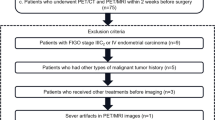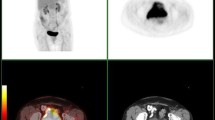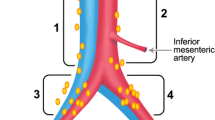Abstract
Purpose
To evaluate the accuracy of integrated positron emission tomography and computed tomography (PET/CT) with iodinated contrast agent and 18F-fluorodeoxyglucose (FDG) in the diagnosis of suspected uterine cancer recurrence and to assess the impact of PET/CT findings on clinical management, compared with PET alone and enhanced CT alone.
Methods
Of 103 women who had undergone treatment for histopathologically proven uterine cervical or endometrial cancer, 90 underwent FDG-PET/contrast-enhanced CT examination for suspected recurrence. PET-alone, CT-alone, and fused PET/CT images were interpreted by two radiologists by consensus for each investigation. Lesion status was determined on the basis of histopathology, radiological imaging and clinical follow-up for longer than 6 months. Differences among the three modalities were tested using the Cochran Q test, followed by multiple comparisons using the McNemar test with Bonferroni adjustment.
Results
Patient-based analysis showed that the sensitivity, specificity, and accuracy of PET alone were 79.5% (35/44), 73.9% (34/46), and 76.7% (69/90), respectively, whereas those of CT alone were 68.2% (30/44), 87.0% (40/46), and 77.8% (70/90), respectively, and those of PET/CT were 90.9% (40/44), 93.5% (43/46), and 92.2% (83/90), respectively. PET/CT findings resulted in a change of management in 38 of the 90 patients (42%) with an additional effect on patient management in 13 patients (14%) diagnosed by CT alone and 14 patients (16%) diagnosed by PET alone.
Conclusion
FDG-PET/contrast-enhanced CT is a more accurate modality for assessing recurrence of uterine cancer, and led to more appropriate subsequent clinical management than that resulting from PET alone or enhanced CT alone.



Similar content being viewed by others
References
Larson DM, Copeland LJ, Stringer CA, Gershenson DM, Malone Jr JM, Edwards CL. Recurrent cervical carcinoma after radical hysterectomy. Gynecol Oncol 1988;30:381–7.
Irvin WP, Rice LW, Berkowitz RS. Advances in the management of endometrial adenocarcinoma. A review. J Reprod Med 2002;47:173–90.
Lo SS, Khoo US, Cheng DK, Ng TY, Wong LC, Ngan HY. Role of serial markers in the surveillance for recurrence in endometrial cancer. Cancer Detect Prev 1999;23:397–400.
Low RN, Sigeti JS. MR imaging of peritoneal disease: comparison of contrast-enhanced fast multiplanar spoiled gradient-recalled and spin-echo imaging. AJR Am J Roentgenol 1994;163:1131–40.
Sugiyama T, Nishida T, Ushijima K, Sato N, Kataoka A, Imaishi K, et al. Detection of lymph node metastasis in ovarian carcinoma and uterine corpus carcinoma by preoperative computerized tomography or magnetic resonance imaging. J Obstet Gynaecol 1995;21:551–6.
Connor JP, Andrews JI, Anderson B, Buller RE. Computed tomography in endometrial carcinoma. Obstet Gynecol 2000;95:692–6.
Pannu HK, Fishmann EK. Evaluation of cervical cancer by computed tomography: current status. Cancer 2003;98:2039–43.
Jeong YY, Kong HK, Chung TW, Seo JJ, Park JG. Uterine cervical carcinoma after therapy: CT and MR imaging findings. Radiographics 2003;23:968–81.
Pannu HK, Bristow RE, Montz FJ, Fishman EK. Multidetector CT of peritoneal carcinomatosis from ovarian cancer. Radiographics 2003;23:687–701.
Cook GJ, Maisey MN, Fogelman I. Normal variants, artifacts and interpretative pitfalls in PET imaging with 18-fluoro-2-deoxyglucose and carbon-11 methionine. Eur J Nucl Med 1999;26:1363–78.
Kostakoglu L, Agress H Jr, Goldsmith SJ. Clinical role of FDG PET in evaluation of cancer patients. Radiographics 2003;23:315–40.
Beyer T, Townsend DW, Brun T, Kinahan PE, Charron M, Roddy R, et al. A combined PET/CT scanner for clinical oncology. J Nucl Med 2000;41:1369–79.
Bar-Shalom R, Yefremov N, Guralnik L, Gaitini D, Frenkel A, Kuten A, et al. Clinical performance of PET/CT in evaluation of cancer: additional value for diagnostic imaging and patient management. J Nucl Med 2003;44:1200–9.
Ryu SY, Kim MH, Choi SC, Choi CW, Lee KH. Detection of early recurrence with 18F-FDG PET in patients with cervical cancer. J Nucl Med 2003;44:347–52.
Havrilesky LJ, Wong TZ, Secord AA, Berchuck A, Clarke-Pearson DL, Jones EL. The role of PET scanning in the detection of recurrent cervical cancer. Gynecol Oncol 2003;90:186–90.
Lai CH, Huang KG, See LC, Yen TC, Tsai CS, Chang TC, et al. Restaging of recurrent cervical carcinoma with dual-phase [18F]fluoro-2-deoxy-D-glucose positron emission tomography. Cancer 2004;100:544–52.
Chang TC, Law KS, Hong JH, Lai CH, Ng KK, Hsueh S, et al. Positron emission tomography for unexplained elevation of serum squamous cell carcinoma antigen levels during follow-up for patients with cervical malignancies: a phase II study. Cancer 2004;101:164–71.
Yen TC, See LC, Chang TC, Huang KG, Ng KK, Tang SG, et al. Defining the priority of using 18F-FDG PET for recurrent cervical cancer. J Nucl Med 2004;45:1632–9.
Belhocine T, Debarsy C, Hustinx R, Willems-Foidart J. Usefulness of 18F-FDG PET in the post-therapy surveillance of endometrial carcinoma. Eur J Nucl Med Mol Imaging 2002;9:1132–9.
Saga T, Higashi T, Ishimori T, Mamede M, Nakamoto Y, Mukai T, et al. Clinical value of FDG-PET in the follow up of post-operative patients with endometrial cancer. Ann Nucl Med 2003;17:197–203.
Chao A, Chang TC, Ng KK, Hsueh S, Huang HJ, Chou HH, et al. 18F-FDG PET in the management of endometrial cancer. Eur J Nucl Med Mol Imaging 2006;33:36–44.
Chung HH, Jo H, Kang WJ, Kim JW, Park NH, Song YS, et al. Clinical impact of integrated PET/CT on the management of suspected cervical cancer recurrence. Gynecol Oncol 2007;104:529–34.
Sironi S, Picchio M, Landoni C, Galimberti S, Signorelli M, Bettinardi V, et al. Post-therapy surveillance of patients with uterine cancers: value of integrated FDG PET/CT in the detection of recurrence. Eur J Nucl Med Mol Imaging 2007;34:472–9.
Kitajima K, Murakami K, Yamasaki E, Hagiwara S, Fukasawa I, Inaba N, et al. Performance of FDG-PET/CT in the diagnosis of recurrent endometrial cancer. Ann Nucl Med 2008;22:103–9.
Park JY, Kim EN, Kim DY, Suh DS, Kim JH, Kim YM, et al. Clinical impact of positron emission tomography or positron emission tomography/computed tomography in the posttherapy surveillance of endometrial carcinoma: evaluation of 88 patients. Int J Gynecol Cancer 2008; [Epub ahead of print]. doi:10.1111/j.1525-1438.2008.01197.x
Chung HH, Kang WJ, Kim JW, Park NH, Song YS, Chung JK, et al. The clinical impact of [18F]FDG PET/CT for the management of recurrent endometrial cancer: correlation with clinical and histological findings. Eur J Nucl Mol Imaging 2008;35:1081–8.
Kitajima K, Murakami K, Yamasaki E, Domeki Y, Kaji Y, Sugimura K. Performance of FDG-PET/CT for diagnosis of recurrent uterine cervical cancer. Eur Radiol 2008;18:2040–7.
Antoch G, Stattaus J, Nemat AT, Marnitz S, Beyer T, Keuhl H, et al. Non-small cell lung cancer: dual-modality PET/CT in preoperative staging. Radiology 2003;229:526–33.
Antoch G, Saoudi N, Kuehl H, Dahmen G, Mueller SP, Beyer T, et al. Accuracy of whole-body dual-modality fluorine-18-2-fluoro-2-deoxy-D-glucose positron emission tomography and computed tomography (FDG-PET/CT) for tumor staging in solid tumors: comparison with CT and PET. J Clin Oncol 2004;22:4357–68.
Kitajima K, Murakami K, Yamasaki E, Fukasawa I, Inaba N, Kaji Y, et al. Accuracy of FDG PET/CT in detecting pelvic and paraaortic lymph node metastasis in patients with endometrial cancer. AJR Am J Roentgenol 2008;190:1652–8.
Loft A, Berthelsen AK, Roed H, Ottosen C, Lundvall L, Knudsen J, et al. The diagnostic value of PET/CT scanning in patients with cervical cancer: a prospective study. Gynecol Oncol 2007;106:29–34.
Pannu HK, Cohade C, Bristow RE, Fishman EK, Wahl RL. PET-CT detection of abdominal recurrence of ovarian cancer: radiologic-surgical correlation. Abdom Imaging 2004;29:398–403.
Manfredi R, Mirk P, Maresca G, Margariti PA, Testa A, Zannoni GF, et al. Local-regional staging of endometrial carcinoma: role of MR imaging in surgical planning. Radiology 2004;231:372–8.
Rockall AG, Sohaib SA, Haristinghani MG, Babar SA, Singh N, Jeyarajah AR, et al. Diagnostic performance of nanoparticle-enhanced magnetic resonance imaging in the diagnosis of lymph node metastases in patients with endometrial and cervical cancer. J Clin Oncol 2005;23:2813–21.
Coleman ER, Delbeke D, Guiberteau MJ, Conti PS, Royal HD, Weinre JC, et al. Concurrent PET/CT with an integrated imaging system: intersociety dialogue from the joint working group of the American College of Radiology, the Society of Nuclear Medicine, and the Society of Computed Body Tomography and Magnetic Resonance. J Nucl Med 2005;46:1225–39.
Rodriguez-Vigil B, Gomez-Leon N, Pinilla I, Hernandez-Maraver D, Coya J, Martin-Curto L, et al. PET/CT in lymphoma: prospective study of enhanced full-dose PET/CT versus unenhanced low-dose PET/CT. J Nucl Med 2006;7:1643–8.
Mawlawi O, Erasmus JJ, Munden RF, Pan T, Knight A, Macapinlac HA, et al. Quantifying the effect of IV contrast media on integrated PET/CT: clinical evaluation. AJR Am J Roentgenol 2006;186:308–19.
Antoch G, Freudenberg LS, Beyer T, Bockisch A, Debatin JF. To enhance or not to enhance? 18F-FDG and CT contrast agents in dual-modality 18F-FDG PET/CT. J Nucl Med 2004;45:56–65.
Pfannenberg AC, Aschoff P, Brechtel K, Muller M, Bares R, Paulsen F, et al. Low dose non-enhanced CT versus standard dose contrast-enhanced CT in combined PET/CT protocols for staging and therapy planning in non-small cell lung cancer. Eur J Nucl Med Mol Imaging 2007;34:36–44.
Kitajima K, Murakami K, Yamasaki E, Domeki Y, Kaji Y, Fukasawa I, et al. Performance of integrated FDG-PET/contrast-enhanced CT in the diagnosis of recurrent ovarian cancer: comparison with integrated FDG-PET/non-contrast-enhanced CT and enhanced CT. Eur J Nucl Med Mol Imaging 2008;35:1439–48.
Acknowledgments
We thank the gynaecologists, especially Ichio Fukasawa, Noriyuki Inaba for recruiting patients to undergo PET/CT. We also thank Kennichi Kobayashi, Kouichi Asano, Kazufumi Suzuki, and Kaoru Ishida for their excellent technical assistance and generous support.
Author information
Authors and Affiliations
Corresponding author
Rights and permissions
About this article
Cite this article
Kitajima, K., Murakami, K., Yamasaki, E. et al. Performance of integrated FDG-PET/contrast-enhanced CT in the diagnosis of recurrent uterine cancer: comparison with PET and enhanced CT. Eur J Nucl Med Mol Imaging 36, 362–372 (2009). https://doi.org/10.1007/s00259-008-0956-1
Received:
Accepted:
Published:
Issue Date:
DOI: https://doi.org/10.1007/s00259-008-0956-1




